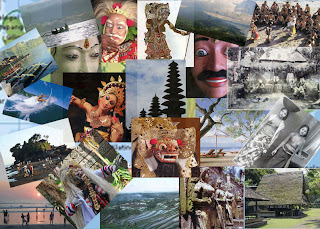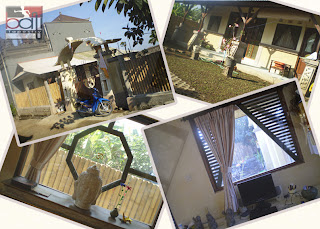 |
| Bali's image compilation |
Bali is one of most popular tourist destination in the world especially in Southeast Asia. Bali is small and unique beautiful island in Indonesian archipelago is approximately 153 km (95 mi) wide and spans approximately 112 km (69 mi) north to south; its land area is 5,632 km². Balinese culture was strongly influenced by Indian and Chinese, and particularly Hindu culture, in a process beginning around the 1st century AD.
The Hindu Majapahit Empire (1293–1520 AD) on eastern Java founded a Balinese colony in 1343. When the empire declined, there was an exodus of intellectuals, artists, priests and musicians from Java to Bali in the 15th century .Some religious and cultural traditions still in existence today. Balinese Hinduism has roots in Indian Hinduism and in Buddhism, and adopted the animistic traditions of the indigenous people.
The glories era Hinduism and Buddhism still in existence today in Java we could trace back on Borobudur temple (Buddhism) and Prambanan temple (Hindu) as a proof that both religion live side by side in harmony. About 93.18% of Bali's population adheres to Balinese Hinduism formed as a combination of existing local beliefs and Hindu influences from mainland Southeast Asia and South Asia. 6.82% are Islam, Christianity and Buddhism excluding immigrants from other parts of Indonesia. Though different in raze, custom and religion we live together hand in hand in harmony.
Balinese Hinduism is an amalgam in which gods and demigods are worshipped together with Buddhist heroes, the spirits of ancestors, indigenous agricultural deities and sacred places. Religion as it is practiced in Bali is a composite belief system that embraces not only theology, philosophy, and mythology, but ancestor worship, animism and magic.The first European contact with Bali is thought to have been made in 1585 by Portuguese. In 1597 the Dutch explorer Cornelis de Houtman arrived at Bali and, with the establishment of the Dutch East India Company in 1602, from then the name of Bali spread rapidly throughout Europe and the world. In the 1930s, anthropologists Margaret Mead and Gregory Bateson, and artists Miguel Covarrubias and Walter Spies, and musicologist Colin McPhee created a western image of Bali as "an enchanted land of aesthetes at peace with themselves and nature", and western tourism first developed on the island
 |
| Bali tapestry's office |
 Bali Tapestry is one of the home industries producing embroidered tapestry with Balinese style which formerly used to decorating the temple and palace or decorated in a room of royal figure or high status people’s house. We really do made differences between tapestries for temple necessity and non temple necessity. Tapestry for temple necessity is depicting of deity and story of other holly spirit which usually derive from “Purana” (one of a Hindu’s holly book), and we are not selling for public necessity. We are selling the tapestry is being derived from commonly depict story of Ramayana ( Hindu epic journey of king Rama), Mahabharata ( illustrating the big family’s of king Bharata), Jataka (Buddha’s journey towards enlightenments) as well as historical scene and also Balinese dance, Balinese daily life, auspicious animal and astrology. Balinese tapestries are made by using such material like: linen, silk, velvet and cotton adorned with a plain and metallic, silver, gold threads, metal sequins, bead and glass stone. Balinese tapestry is made by hand with traditional style. All the needle work such as attaching the figure, thread, stitching the sequin, bead, glass bead sewing the border all are doing by hand. Working of process Balinese tapestry‘s begin by stretching the designed base fabric onto the frame by attaching it. Cutting clothe has been decorated as a figure and attaching to base designed fabric, the figure is stuffed with kapok to give an emboss look and then decorating the base designed fabric with swirled patterns of sequins. The last is setting the outer border wrapping the back side and edges of the embroidered panel. Tapestry ready to be hung.The size of tapestry is approximately not exactly square and rectangular some often the left side slightly taller or wider to the other. All of the tapestry sells here relatively new not less than fife years. we do made intentionally Some of the piece appear here to have an antique look or simulated aging by choosing certain material and color or a certain process.
Bali Tapestry is one of the home industries producing embroidered tapestry with Balinese style which formerly used to decorating the temple and palace or decorated in a room of royal figure or high status people’s house. We really do made differences between tapestries for temple necessity and non temple necessity. Tapestry for temple necessity is depicting of deity and story of other holly spirit which usually derive from “Purana” (one of a Hindu’s holly book), and we are not selling for public necessity. We are selling the tapestry is being derived from commonly depict story of Ramayana ( Hindu epic journey of king Rama), Mahabharata ( illustrating the big family’s of king Bharata), Jataka (Buddha’s journey towards enlightenments) as well as historical scene and also Balinese dance, Balinese daily life, auspicious animal and astrology. Balinese tapestries are made by using such material like: linen, silk, velvet and cotton adorned with a plain and metallic, silver, gold threads, metal sequins, bead and glass stone. Balinese tapestry is made by hand with traditional style. All the needle work such as attaching the figure, thread, stitching the sequin, bead, glass bead sewing the border all are doing by hand. Working of process Balinese tapestry‘s begin by stretching the designed base fabric onto the frame by attaching it. Cutting clothe has been decorated as a figure and attaching to base designed fabric, the figure is stuffed with kapok to give an emboss look and then decorating the base designed fabric with swirled patterns of sequins. The last is setting the outer border wrapping the back side and edges of the embroidered panel. Tapestry ready to be hung.The size of tapestry is approximately not exactly square and rectangular some often the left side slightly taller or wider to the other. All of the tapestry sells here relatively new not less than fife years. we do made intentionally Some of the piece appear here to have an antique look or simulated aging by choosing certain material and color or a certain process. Price of tapestry depend on several factor such as size, conditions, age, design, material and also step of difficulties on embroidered and sequined.Since the Balinese tapestry is doing on mixed-media, somehow the condition is not always perfect. In any matter you will find border get torn, sequins and glass stone get fall off, color fade, details weaker during storage occasionally. Please keep in mind that all these type of matter is considering a normal feature of Balinese tapestry.
We suggest you the best way to display tapestry is hung between a pair a curtain rod, top and bottom facing to the source of the soft naturally light so the gold thread and sequins reflecting shiny light. If you wish to frame the tapestry, we suggest you to not put a glass over it so the sense of the beautiful of the wickerwork of the gold thread and sequins still seen tangible.
Hopefully the special work of art from Bali Tapestry could be a treasure thing on future times.

